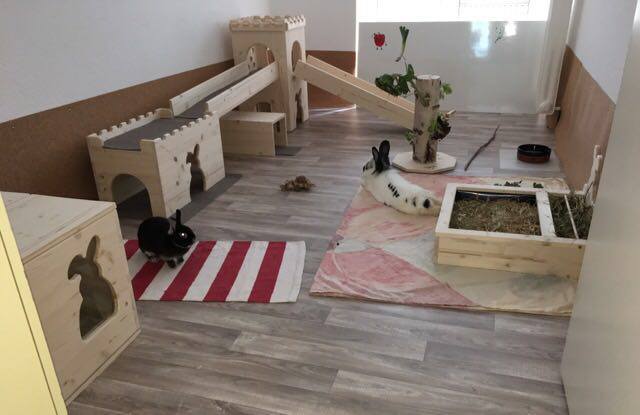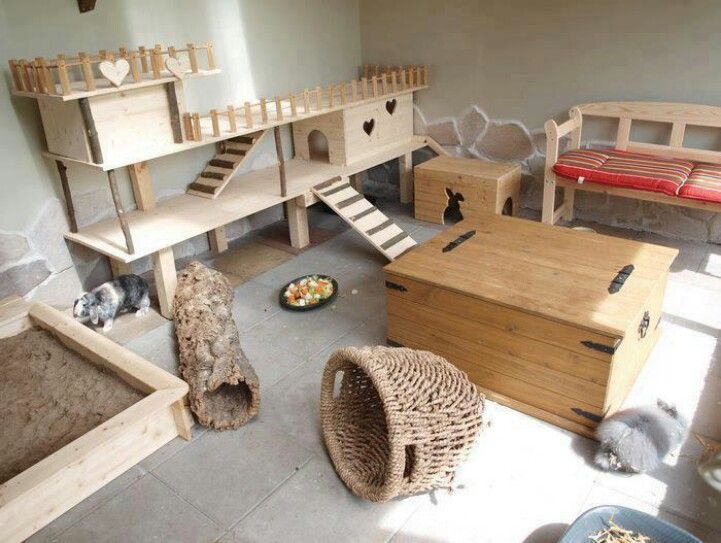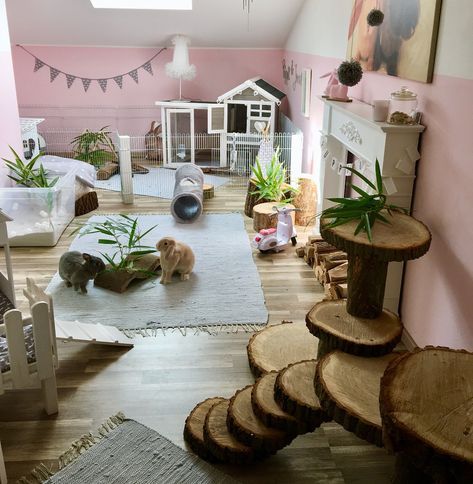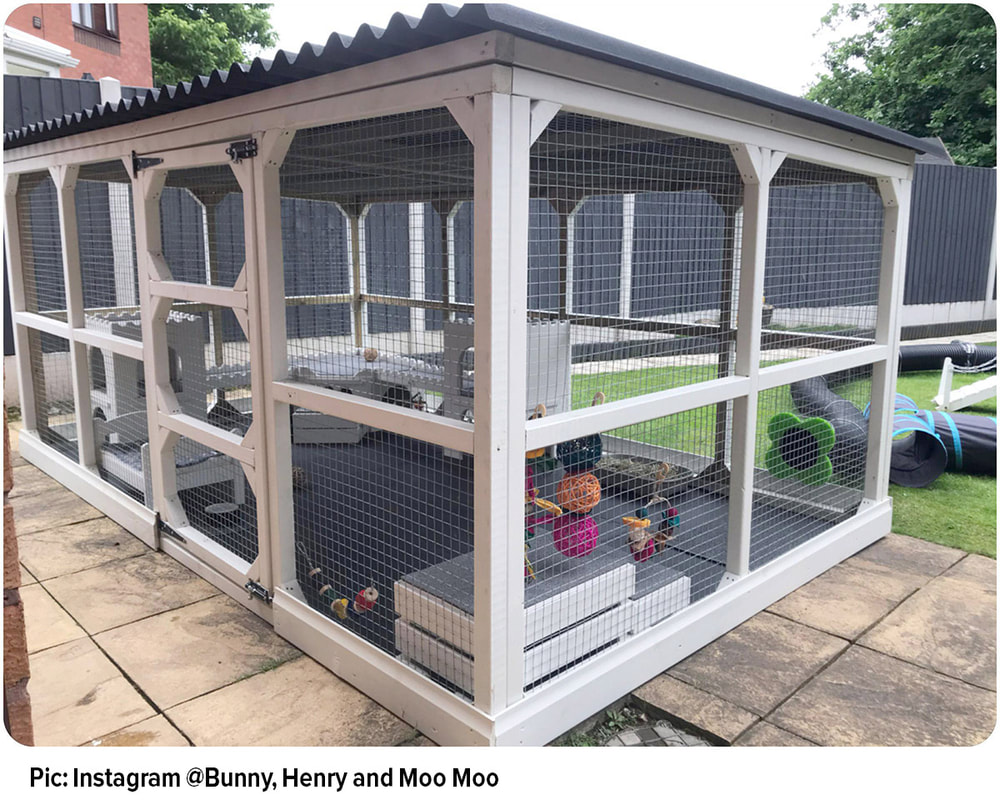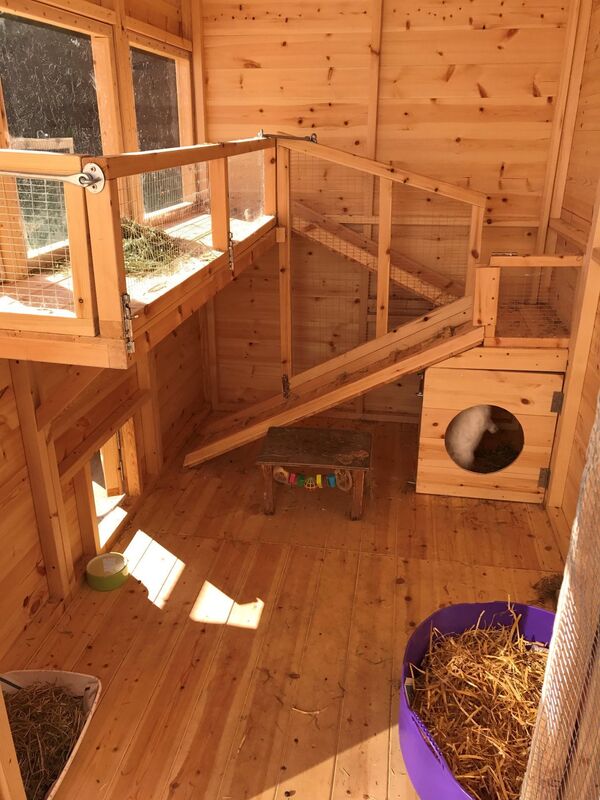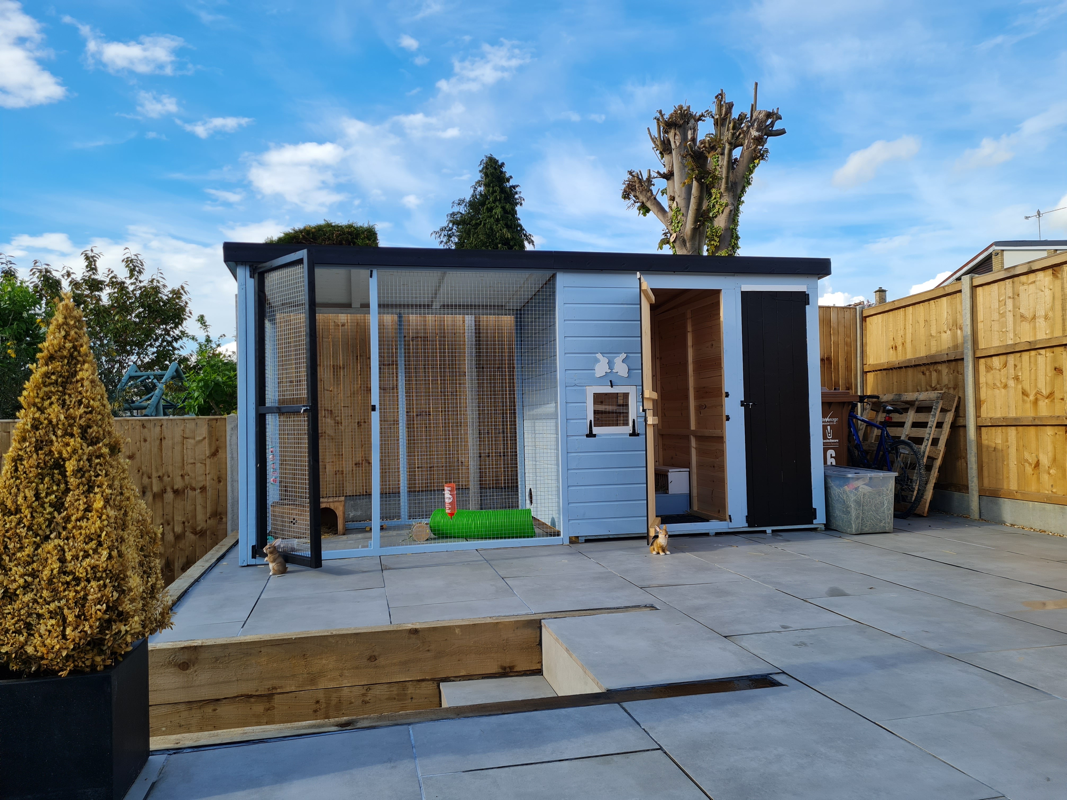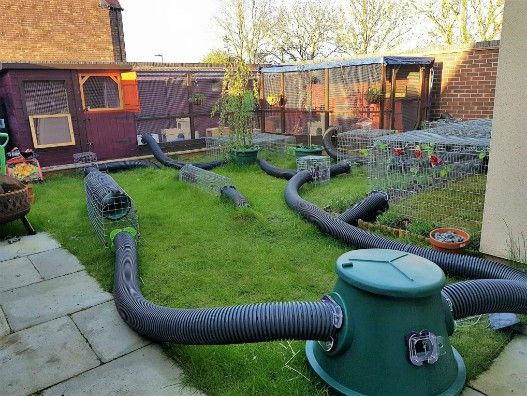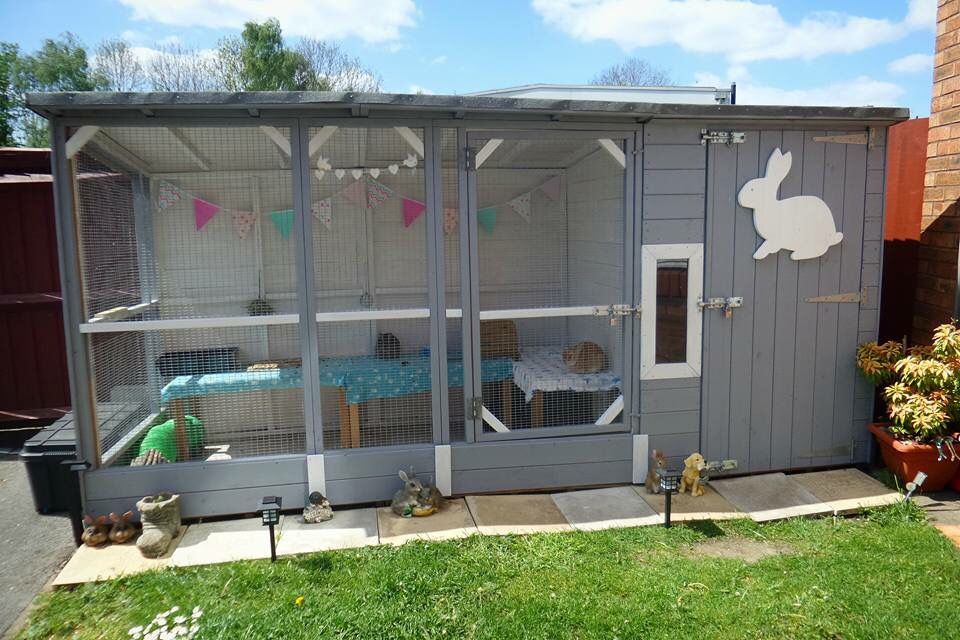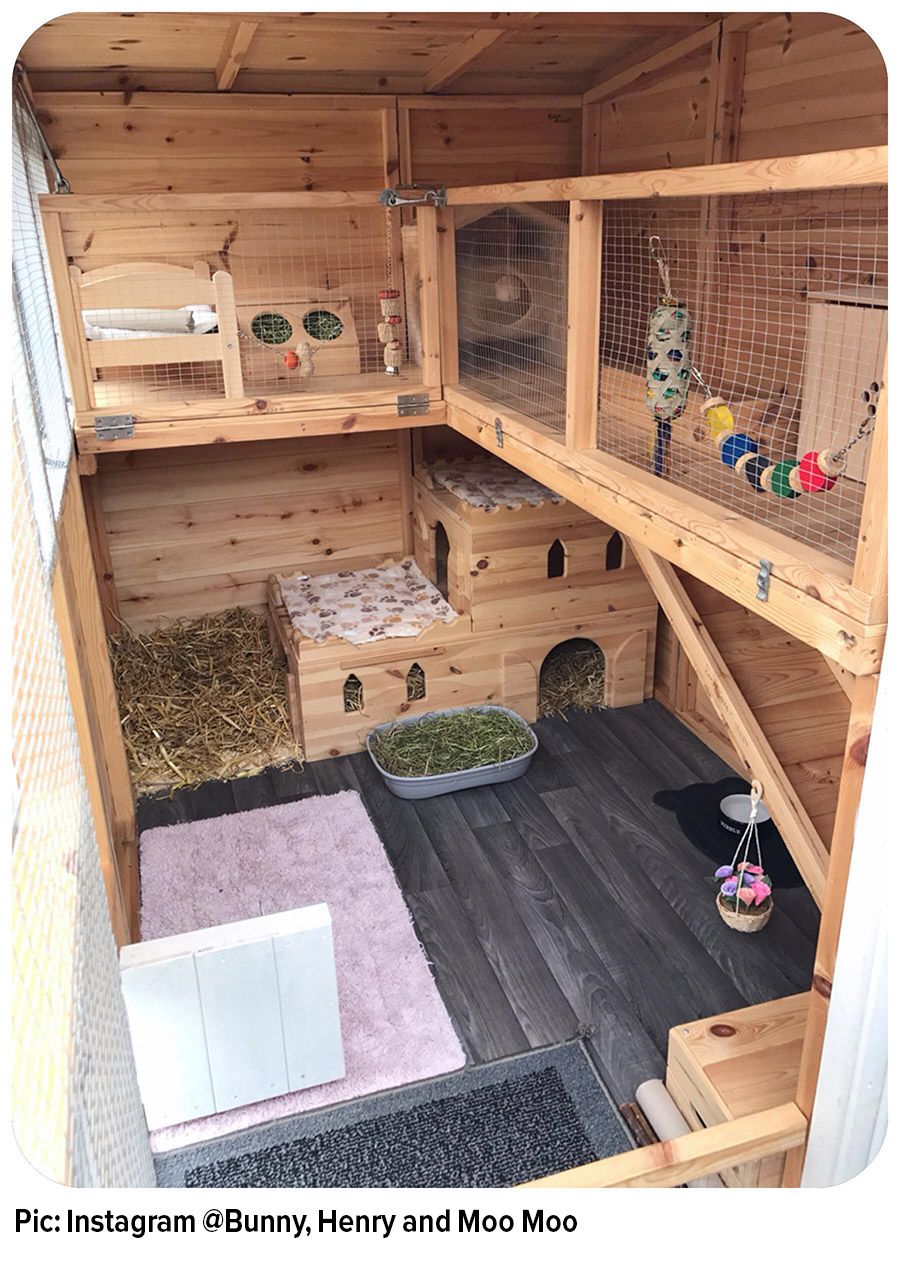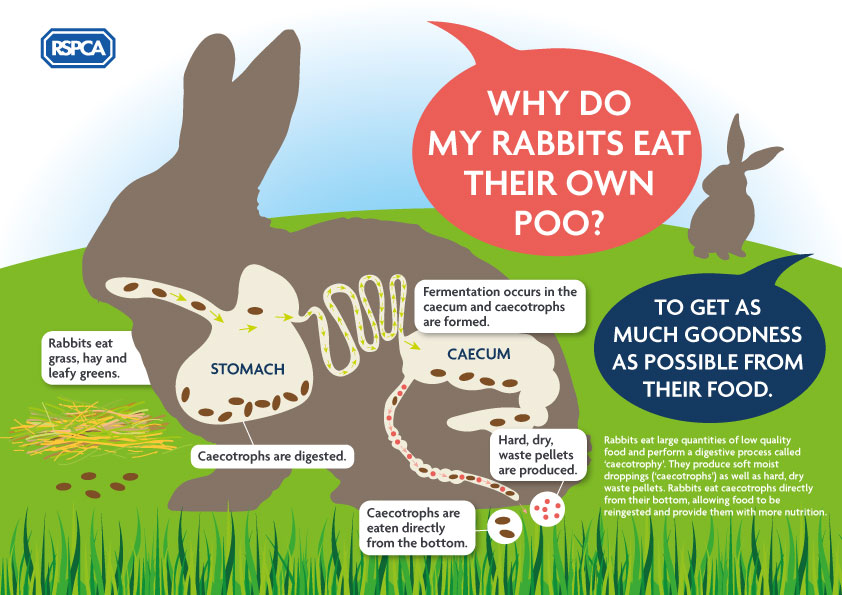General Information:
Contrary to popular belief, rabbits are not rodents, they’re lagomorphs. Rodents have two sets of continuously growing incisors, whereas lagomorphs have four pairs.
Rabbits are well known for their distinctive characteristics such as their long ears, short tail, and strong hind limbs.
The lifespan of a wild rabbit is around 1-2 years because of the number of predators and challenges a rabbit can encounter in their daily life. In captivity, a rabbit can live roughly 10 years or older if well-cared for, but as a rescue, we increasingly see shortened lifespan attributed to poor health often subsequent to neglect. Rabbits do not make good pets and the argument regarding if it is even ethical to keep them in captivity at all certainly carries a lot of weight. They're considered the UK's most neglected pet.
All rabbits are natural herbivores, they’re designed to consume plant-based materials. It’s estimated a rabbit can spend up to 6-8 hours a day eating. They’re crepuscular animals, meaning most active around dusk and dawn. They spend most of their time in their burrows/warrens eating, digging, foraging, socialising, grooming, and playing.
Care:
Housing/Enrichment:
Housing requirements for your rabbit varies depending on if you’re keeping them indoors or outdoors. Firstly, we recommend reading the Rabbit Welfare Association Fund's housing requirements: rabbitwelfare.co.uk/rabbit-care-advice/rabbit-housing/
Indoor:
We highly recommend ‘bunny-proofing’ a part of your home. Most people use a spare bedroom, office, or utility area. Make sure your rabbit isn't at risk of chewing any electrics or escaping.
If you can’t convert a spare room, you can have custom-built enclosures that are designed to fit into a dedicated rabbit-space.
Rabbits need space and lots of it!
Their enclosure/rabbit-room should be a minimum 60sqft. Even though kept indoors, rabbits still require the same opportunities as a rabbit kept outside. They need to run, jump, binky, dig, play, interact - every natural behaviour needs to be able to be displayed.
Ideal temperatures for indoor rabbits should be between 16°C-21°C should be around 45%-65%.
Useful Links:
Contrary to popular belief, rabbits are not rodents, they’re lagomorphs. Rodents have two sets of continuously growing incisors, whereas lagomorphs have four pairs.
Rabbits are well known for their distinctive characteristics such as their long ears, short tail, and strong hind limbs.
The lifespan of a wild rabbit is around 1-2 years because of the number of predators and challenges a rabbit can encounter in their daily life. In captivity, a rabbit can live roughly 10 years or older if well-cared for, but as a rescue, we increasingly see shortened lifespan attributed to poor health often subsequent to neglect. Rabbits do not make good pets and the argument regarding if it is even ethical to keep them in captivity at all certainly carries a lot of weight. They're considered the UK's most neglected pet.
All rabbits are natural herbivores, they’re designed to consume plant-based materials. It’s estimated a rabbit can spend up to 6-8 hours a day eating. They’re crepuscular animals, meaning most active around dusk and dawn. They spend most of their time in their burrows/warrens eating, digging, foraging, socialising, grooming, and playing.
Care:
Housing/Enrichment:
Housing requirements for your rabbit varies depending on if you’re keeping them indoors or outdoors. Firstly, we recommend reading the Rabbit Welfare Association Fund's housing requirements: rabbitwelfare.co.uk/rabbit-care-advice/rabbit-housing/
Indoor:
We highly recommend ‘bunny-proofing’ a part of your home. Most people use a spare bedroom, office, or utility area. Make sure your rabbit isn't at risk of chewing any electrics or escaping.
If you can’t convert a spare room, you can have custom-built enclosures that are designed to fit into a dedicated rabbit-space.
Rabbits need space and lots of it!
Their enclosure/rabbit-room should be a minimum 60sqft. Even though kept indoors, rabbits still require the same opportunities as a rabbit kept outside. They need to run, jump, binky, dig, play, interact - every natural behaviour needs to be able to be displayed.
Ideal temperatures for indoor rabbits should be between 16°C-21°C should be around 45%-65%.
Useful Links:
Outdoor:
Common choices for an outdoor enclosure include a shed conversion and predator proof run, or a complete custom build.
Your pet should be able to move freely between their run and their enclosure at all times of day. This allows a retreat to safety when threatened, and the ability to play when bored.
Your rabbits living area and play area must be secure from local predators and extreme weather conditions.
Both indoor and outdoor rabbits must be able to carry out their natural behaviours, otherwise, they can become bored and depressed easily. They should have access to hay feeders, litter trays, resting areas, a water bottle and bowl, chew toys, play toys, and a digging area.
Useful Links:
Common choices for an outdoor enclosure include a shed conversion and predator proof run, or a complete custom build.
Your pet should be able to move freely between their run and their enclosure at all times of day. This allows a retreat to safety when threatened, and the ability to play when bored.
Your rabbits living area and play area must be secure from local predators and extreme weather conditions.
Both indoor and outdoor rabbits must be able to carry out their natural behaviours, otherwise, they can become bored and depressed easily. They should have access to hay feeders, litter trays, resting areas, a water bottle and bowl, chew toys, play toys, and a digging area.
Useful Links:
Socialising:
Rabbits are very social and would live amongst other rabbits in the wild. We highly recommend getting two non-breeding rabbits. Rabbits need companionship! The most stable bonds are between neutered rabbits; this means breeds, size, genders etc doesn't matter in regards to companionship.
If you have a lone rabbit in need of a friend, contact a local rescue! Most rescues will also offer a bonding service when adopting from them.
Useful Links:
Diet:
Your rabbit’s diet is one of the most important elements of proper rabbit care. Ensuring your rabbit has the correct diet can prevent many health problems and ensures their body can function properly. Rabbits are strictly herbivores, they’re anatomically and physiologically designed to eat plant material.
Firstly, a rabbit’s diet should be as close to these proportions as possible:
What vegetation/forage you decide is entirely your choice – so long as it’s safe to consume. Be mindful when introducing new foods as it can cause an upset stomach.
If you're opting to feed pellets, it is important you provide high-quality pellets into their diet and be mindful of the ingredients within many commercial brands.
Don't feed your rabbit muesli. Muesli may look more appealing to us, but muesli provides no benefit to rabbits as it enables selective feeding and contributes to dental issues.
Pellets should approximately contain:
Be mindful about portion sizes – moderation is key.
Useful Links:
Faeces:
Coprophagy is the proper term for the consumption of faeces. To humans, the idea can be utterly revolting, however, it is an essential behaviour for rabbits.
Rabbits produce two different types of droppings:
Rabbits are very social and would live amongst other rabbits in the wild. We highly recommend getting two non-breeding rabbits. Rabbits need companionship! The most stable bonds are between neutered rabbits; this means breeds, size, genders etc doesn't matter in regards to companionship.
If you have a lone rabbit in need of a friend, contact a local rescue! Most rescues will also offer a bonding service when adopting from them.
Useful Links:
- rabbitwelfare.co.uk/rabbit-care-advice/behaviour/rabbit-companionship/
- www.theveterinarynurse.com/review/article/stranger-danger-the-importance-and-perils-of-companionship-in-rabbits
Diet:
Your rabbit’s diet is one of the most important elements of proper rabbit care. Ensuring your rabbit has the correct diet can prevent many health problems and ensures their body can function properly. Rabbits are strictly herbivores, they’re anatomically and physiologically designed to eat plant material.
Firstly, a rabbit’s diet should be as close to these proportions as possible:
- 90% of grass hay
- 5% of natural herbs and forage
- 5% of healthy pellets - you can provide a rabbit with a healthy diet even in the abscence of pellets.
What vegetation/forage you decide is entirely your choice – so long as it’s safe to consume. Be mindful when introducing new foods as it can cause an upset stomach.
If you're opting to feed pellets, it is important you provide high-quality pellets into their diet and be mindful of the ingredients within many commercial brands.
Don't feed your rabbit muesli. Muesli may look more appealing to us, but muesli provides no benefit to rabbits as it enables selective feeding and contributes to dental issues.
Pellets should approximately contain:
- 22% crude fibre
- 14% protein
- 1% fat
- 1% calcium
Be mindful about portion sizes – moderation is key.
Useful Links:
Faeces:
Coprophagy is the proper term for the consumption of faeces. To humans, the idea can be utterly revolting, however, it is an essential behaviour for rabbits.
Rabbits produce two different types of droppings:
- Faecal pellets are small brown odourless balls with no liquid component, they should be plentiful and round. These contain undigested hay and food. Odd shapes and colours can indicate dietary and other health problems. If you notice abnormal droppings you should contact your veterinarian for advice.
- Cecotrophes are Informally known as 'night droppings' as they're usually produced at night. They're a nitrogen-rich soft faeces pressed together cased in a thin film of mucus. To get all their vital nutrients, a rabbit must digest some of their food twice. It's very important that your rabbit actually eats these droppings. They’re full of nutritious food that has been sent to the appendix (caecum) and then expelled as a nutritious fermented sack. If your rabbit is leaving too many of these droppings or has a dirty bottom, the most common cause is an unbalanced diet or other issues such as arthritis. We'd recommend reevaluating your rabbit’s diet proportions and what foods you’re feeding your rabbit. Often, a diet can be improved/adjusted to suit your rabbits’ individual needs. Ensure your rabbit's rear end is kept clean, a dirty bottom puts your rabbit at risk of flystrike!
Health:
To keep your rabbit in good health, you'll have to take preventative measures (prophylactics). Your rabbit must be neutered and vaccinated.
Neutering:
It's a misconception that death is likely when having your rabbit neutered. When performed by an experienced veterinarian, it's a very safe procedure.
'The House of Rabbit Society' has had over 1000 rabbits neutered, and have found that on average, there is a less than 1% mortality rate.
Does (females) can be spayed (ovariohysterectomy) at around 4-6 months old, this is when they become sexually mature. Most veterinarians prefer to wait till around 6 months old as surgery is a bit riskier on younger rabbits.
Bucks (males) can be castrated (orchiectomy) from 8-12 weeks as this is when the testicles descend.
Older rabbits can be altered, consult with your veterinarian for their pre-operative advice and requirements – this will vary depending on age.
Why should you neuter your rabbit?
Vaccinations:
Your rabbit's vaccination requirements will vary depending on your location. In the UK, you’re advised to vaccinate against Myxomatosis and Rabbit Hemorrhagic Disease (RHD) - strain 1 and 2
Rabbits can be vaccinated from around 5 weeks old. Your rabbit will require boosters for the remainder of their life – your veterinarian will advise you on how often your rabbit requires boosters.
We are firm believers that preventative medicine and management is far superior to waiting to treat illnesses.
Myxomatosis:
If your unvaccinated rabbit receives a diagnosis of myxomatosis, the prognosis is extremely poor. Myxomatosis is nearly always fatal. Most often, the kindest thing to do is have your rabbit humanely euthanised.
What is Myxomatosis?
Myxomatosis is a disease that attacks a rabbit’s face, lungs, and genitals. It can be passed on from wild rabbits, as well as insects such as fleas and mites.
Myxomatosis can live in your rabbit’s environment for a long time, so it can quickly and easily kill all your rabbits.
Prevention of Myxomatosis:
Rabbit Haemorrhagic Disease (RHD):
Sometimes referred to as Viral Haemorrhagic Disease (VHD), it's almost always fatal to rabbits who contract the viral disease. Sadly, rabbits often die before showing any symptoms at all.
What is RHD?
There are two strains of RHD: RHD-1 and RHD-2.
The disease will attack a rabbit’s lungs and other organs. It sadly progresses very quickly and can also pass onto other rabbits quickly too.
RHD-1 is common amongst wild rabbits and can spread easily and rapidly. It can spread via the air and direct contact.
Whilst RHD only affects rabbits, other animals can still carry the disease which can then be transmitted to your rabbits. Humans, insects, and other pets can accidentally pick up the virus and then pass it on to your rabbit. RHD-1 has been in the UK for a long time.
RHD-2 is a newer strain that originated in Europe but is now very common amongst the UK. You must get your rabbit(s) vaccinated against both strain 1 and 2 to effectively prevent RHD.
I think one of my rabbits has RHD, what do I do?
If one of your rabbits dies suddenly, you must report this to your vet and get all of your other rabbits examined immediately.
RHD-1 and RHD-2 can live on hutches and other items for a long time, so it’s important that you destroy them and do not use them for your other rabbits unless thoroughly cleaned with virus-killing disinfectant.
Preventing RHD:
Please feel free to ask more questions.
To keep your rabbit in good health, you'll have to take preventative measures (prophylactics). Your rabbit must be neutered and vaccinated.
Neutering:
It's a misconception that death is likely when having your rabbit neutered. When performed by an experienced veterinarian, it's a very safe procedure.
'The House of Rabbit Society' has had over 1000 rabbits neutered, and have found that on average, there is a less than 1% mortality rate.
Does (females) can be spayed (ovariohysterectomy) at around 4-6 months old, this is when they become sexually mature. Most veterinarians prefer to wait till around 6 months old as surgery is a bit riskier on younger rabbits.
Bucks (males) can be castrated (orchiectomy) from 8-12 weeks as this is when the testicles descend.
Older rabbits can be altered, consult with your veterinarian for their pre-operative advice and requirements – this will vary depending on age.
Why should you neuter your rabbit?
- The risk of reproductive cancers (ovarian, uterine, and mammalian) is very high in unaltered rabbits – approximately 80% of all unspayed females develop reproductive cancers. Treatment for some of these illnesses can costly. Long term, it's cheaper, and most importantly, safer to spay your rabbit. By spaying your doe, the risk is almost eliminated.
- Neutered rabbits are much friendlier towards other rabbits and their owners because they're less dominant and territorial.
- Castrated males live longer.
- They are easier to reliably litter train.
- Unneutered males notoriously spray urine to mark their territory.
- They will display less obnoxious behaviours such as biting, lunging, growling, chewing, digging, etc.
Vaccinations:
Your rabbit's vaccination requirements will vary depending on your location. In the UK, you’re advised to vaccinate against Myxomatosis and Rabbit Hemorrhagic Disease (RHD) - strain 1 and 2
Rabbits can be vaccinated from around 5 weeks old. Your rabbit will require boosters for the remainder of their life – your veterinarian will advise you on how often your rabbit requires boosters.
We are firm believers that preventative medicine and management is far superior to waiting to treat illnesses.
Myxomatosis:
If your unvaccinated rabbit receives a diagnosis of myxomatosis, the prognosis is extremely poor. Myxomatosis is nearly always fatal. Most often, the kindest thing to do is have your rabbit humanely euthanised.
What is Myxomatosis?
Myxomatosis is a disease that attacks a rabbit’s face, lungs, and genitals. It can be passed on from wild rabbits, as well as insects such as fleas and mites.
Myxomatosis can live in your rabbit’s environment for a long time, so it can quickly and easily kill all your rabbits.
Prevention of Myxomatosis:
- Vaccinations.
- Insect proof screens.
- Treating other animals for fleas and mites.
- Never letting pet rabbits interact with wild rabbits.
- Keeping an enclosure clean Using a safe virus-killing disinfectant.
- Never reuse items that have been used by rabbits who’ve had a diagnosis of myxomatosis.
Rabbit Haemorrhagic Disease (RHD):
Sometimes referred to as Viral Haemorrhagic Disease (VHD), it's almost always fatal to rabbits who contract the viral disease. Sadly, rabbits often die before showing any symptoms at all.
What is RHD?
There are two strains of RHD: RHD-1 and RHD-2.
The disease will attack a rabbit’s lungs and other organs. It sadly progresses very quickly and can also pass onto other rabbits quickly too.
RHD-1 is common amongst wild rabbits and can spread easily and rapidly. It can spread via the air and direct contact.
Whilst RHD only affects rabbits, other animals can still carry the disease which can then be transmitted to your rabbits. Humans, insects, and other pets can accidentally pick up the virus and then pass it on to your rabbit. RHD-1 has been in the UK for a long time.
RHD-2 is a newer strain that originated in Europe but is now very common amongst the UK. You must get your rabbit(s) vaccinated against both strain 1 and 2 to effectively prevent RHD.
I think one of my rabbits has RHD, what do I do?
If one of your rabbits dies suddenly, you must report this to your vet and get all of your other rabbits examined immediately.
RHD-1 and RHD-2 can live on hutches and other items for a long time, so it’s important that you destroy them and do not use them for your other rabbits unless thoroughly cleaned with virus-killing disinfectant.
Preventing RHD:
- Rabbits can be vaccinated at 5 weeks old. They will require boosters throughout their life, so speak with your veterinarian about when your rabbit will require a booster.
- Quarantine new rabbits for at least 2 weeks after they’ve been vaccinated
- Outdoor rabbits are most at risk of RHD, so keep them secure and away from wild rabbits. It is important to use insect-proof screening to keep them safe and away from insects that could be carriers of the disease.
- Indoor rabbits should be kept away from shoes that have been worn outside and always wash your hands before handling to reduce the risk of accidentally passing on the disease.
Please feel free to ask more questions.

